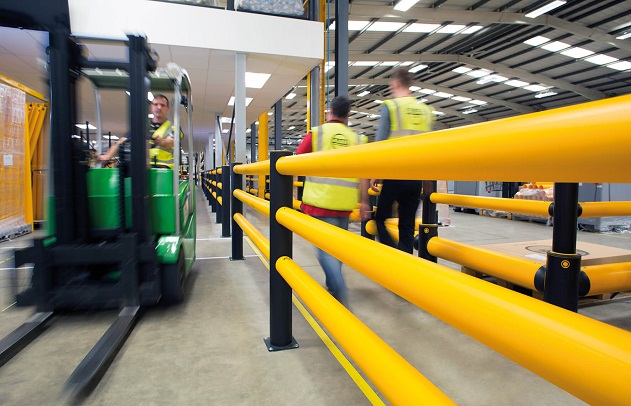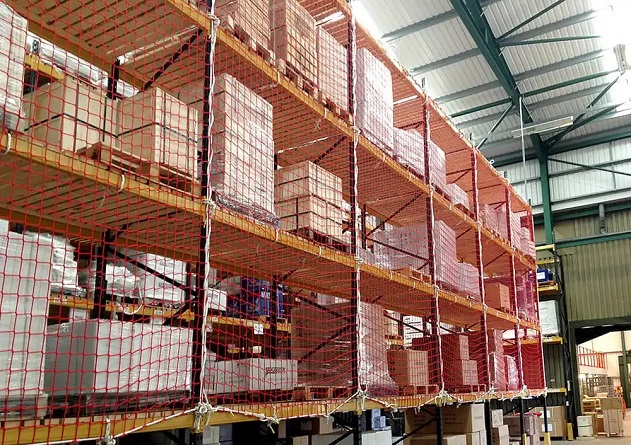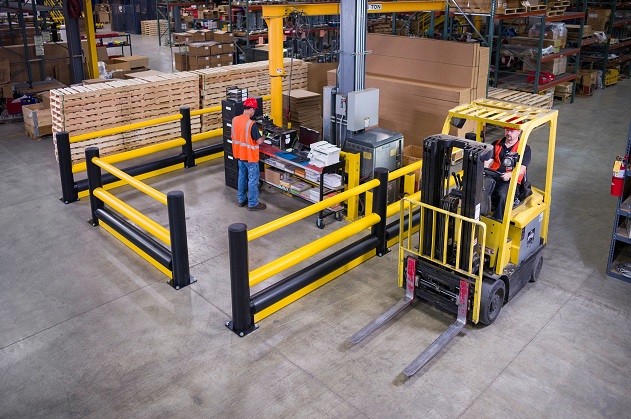Safety First: The Role of Barriers in Warehouse Risk Mitigation
Posted in Industrial Equipment By Ben Eliot On January 24, 2024Warehouses are places bustling with activity, where the efficient movement and storage of goods and the coordination of various tasks are paramount. With this dynamic environment comes a host of potential hazards, making safety a top priority for businesses. One of the staples in warehouse safety strategies is the effective use of safety barriers. In this article, we’ll examine the role of barriers in mitigating risks, exploring the diverse types available, design considerations, and practical tips for implementation.
Understanding Warehouse Risks

Before delving into the specifics of safety barriers, it’s crucial to understand the common risks that warehouse spaces face. Forklift accidents, a frequent occurrence in these settings, pose a significant threat. Then there’s the risk of falling objects, slippery surfaces, and challenges in traffic management which add extra layers of complexity to maintaining a safe environment.
Beyond the immediate human toll, these accidents can result in substantial financial toll for businesses, emphasising the importance of robust safety measures such as sturdy and durable safety barriers.
Types of Safety Barriers
Safety barriers come in various forms, each tailored to address specific risks prevalent in warehouses:
Guardrails
- Fixed vs. Flexible: Fixed guardrails provide a sturdy physical barrier, while flexible options absorb impact energy, minimising damage during collisions.
- Material Options: Guardrails come in materials like steel, aluminium, and plastic, each offering unique benefits in terms of durability and impact resistance.
Bollards
- Purpose and Placement: Bollards are sturdy posts strategically placed to protect critical areas, such as building corners, equipment, or pedestrian walkways.
- Impact Resistance: Choosing bollards with high impact resistance is crucial for effectively preventing collisions.
Safety Netting

- Applications and Benefits: Safety netting is particularly effective in preventing falling objects, creating a protective barrier without obstructing visibility.
- Choosing the Right Netting: Tailor the type of netting to the specific risks in your warehouse, considering factors like mesh size and load-bearing capacity.
Floor Markings and Signage
- Guiding Traffic: Clearly marked floor pathways and signage help direct traffic flow, reducing the risk of collisions and improving overall warehouse navigation.
- Enhancing Visibility: Bright and reflective floor markings contribute to enhanced visibility, reducing the likelihood of slip and fall incidents.
Additional Considerations When Choosing
Besides being aware of the different types of barriers available, you need to consider some additional factors in order to ensure you have the right solutions for your needs. This involves thinking about:
- Warehouse Layout – Consider the specific layout and flow of your warehouse to strategically place barriers where they will be most effective. Analyse high-traffic areas, potential collision points, and zones with elevated risks to determine the optimal placement of barriers.
- Compliance with Standards – Ensure that safety barriers comply with relevant safety standards and regulations to meet legal requirements and industry best practices. Regularly update barrier systems to align with any changes in safety regulations.
- Integration with Other Safety Measures – Safety barriers should complement other safety measures, such as emergency exits, fire extinguishers, and first aid stations.
- Maintenance and Inspection – Establish regular maintenance schedules to inspect and repair safety barriers. Train staff to identify and report any issues promptly, fostering a proactive approach to barrier maintenance.
How to Successfully Implement Safety Barriers in Your Warehouse
Implementing safety barriers is a systematic process. The following steps help ensure a successful implementation within your existing warehouse space.
- Risk Assessment: Conduct a thorough risk assessment to identify potential hazards and determine the most suitable types of barriers for each risk.
- Collaboration with Safety Experts: Work closely with safety experts and professionals to design a barrier system tailored to the specific needs and risks of your warehouse.
- Employee Training: Train employees on barrier awareness and proper usage, emphasizing the importance of respecting safety barriers for their protection.
- Adaptability: Choose barrier systems that are adaptable to changing warehouse needs. Consider modular options that can be easily reconfigured as the layout evolves.
Is It Worth to Invest in Safety Barriers?

The initial investment in safety barriers may seem substantial, but the long-term benefits far outweigh the costs. Accidents incur costs such as medical expenses, worker compensation claims, and potential legal fees. Safety barriers contribute to accident prevention, resulting in substantial financial savings.
Then, there’s the effect on work satisfaction. A safer warehouse environment fosters a positive work culture. Employees feel valued, leading to increased morale, productivity, and overall work satisfaction.
To Sum It Up
Safety barriers are indispensable in warehouse risk mitigation. Understanding the specific risks, selecting the appropriate types of barriers, and customising designs based on warehouse layout are critical steps. Implementing barriers is a collaborative effort with safety experts, comprehensive employee training, and a commitment to ongoing maintenance.
The initial investment in safety barriers is a proactive measure that will pay off in the long run. As technology advances, we anticipate further innovations in warehouse safety. However, the foundational principles of understanding risks, implementing effective barriers, and cultivating a culture of safety will remain paramount in creating secure and efficient warehouse environments. Embracing these principles positions warehouses for a safer, more productive future.
About Author
ben



